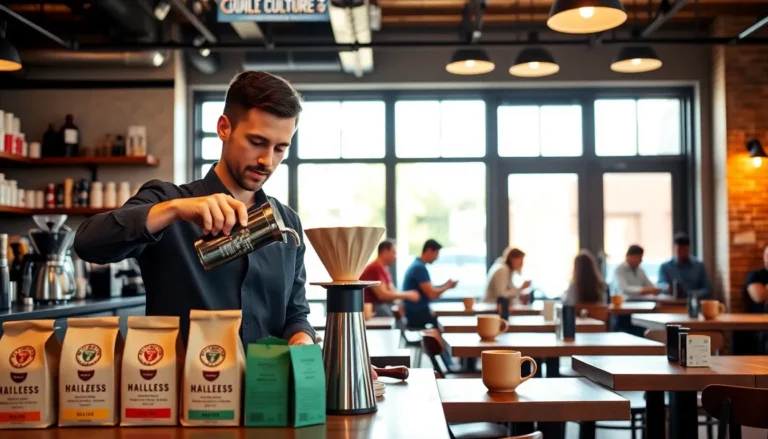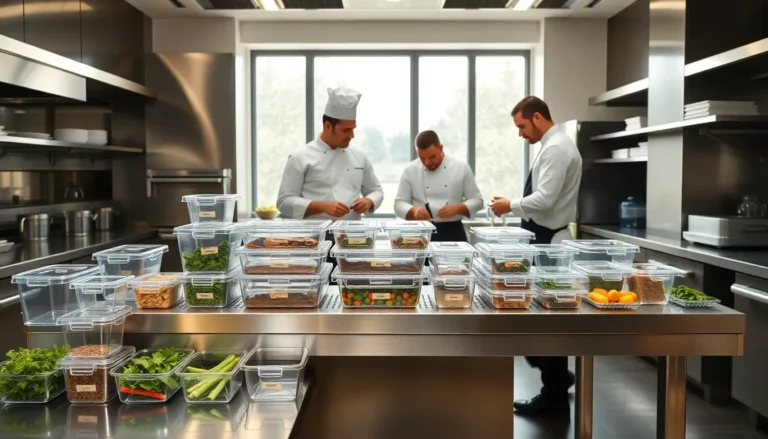In a world where foodies roam and culinary trends change faster than a chef can flip a pancake, restaurant analysis has become the secret sauce for success. Whether it’s a cozy bistro or a bustling food truck, understanding the ins and outs of the dining experience is crucial. After all, who wants to serve a dish that’s as appealing as a soggy napkin?
Table of Contents
ToggleOverview of Restaurant Analysis
Restaurant analysis serves as a critical tool for success in the culinary industry. It encompasses evaluating key components like menu offerings, customer preferences, and overall dining experiences. Small bistros and bustling food trucks benefit from understanding their clientele and market trends. Data collection from customer feedback, sales figures, and competitor assessments enhances decision-making processes.
Key focus areas include food quality, service efficiency, and ambiance. Analyzing menu item performance reveals insights into customer favorites and potential underperformers. For example, a restaurant might find that a specific dish sells well on weekends but lags during weekdays. Such insights guide menu adjustments to meet customer demands effectively.
Service quality plays a pivotal role in customer satisfaction. Understanding staff efficiency and interaction quality directly impacts overall dining experiences. Observations of customer wait times and staff responsiveness contribute to better service strategies.
Ambiance significantly influences a guest’s perception of a restaurant. Elements like lighting, decor, and music must align with the establishment’s theme and target audience. Evaluating these factors helps create a welcoming atmosphere that encourages repeat visits.
Market analysis also examines competitors within the local area. Identifying strengths and weaknesses among similar establishments can illuminate gaps in the market. This competitive landscape analysis enables restaurants to tailor their offerings and marketing strategies accordingly.
Implementing thorough restaurant analysis creates a foundation for long-term success. Staying adaptable in an ever-evolving landscape ensures establishments remain relevant and appealing. Understanding and responding to these insights is vital for any restaurant aiming to thrive and grow.
Key Components of Restaurant Analysis

Restaurant analysis involves examining various aspects crucial for success in the food industry. Understanding market dynamics, competition, and financial health creates a solid base for informed decision-making.
Market Research
Market research identifies customer preferences and local dining trends. Gathering data on demographics, dining habits, and emerging culinary trends informs menu design and promotional strategies. Surveys, social media insights, and reviews provide valuable feedback on what guests seek. Tracking seasonal variations in customer demand helps tailor offerings effectively. Establishments gain a competitive edge by aligning their business strategies with these insights.
Competitive Analysis
Competitive analysis compares a restaurant’s strengths and weaknesses to local rivals. Understanding competitors’ pricing, menu offerings, and customer service practices enables establishments to differentiate themselves. Evaluating customer reviews and ratings reveals areas for improvement and unique selling points. Identifying gaps in the market allows restaurants to fill unmet needs. Adapting strategies based on competitive insights drives customer engagement and loyalty.
Financial Assessment
Financial assessment evaluates a restaurant’s fiscal health and sustainability. Examining revenue streams, operational costs, and profit margins provides insight into overall performance. Analyzing sales figures helps identify top-performing menu items and underperformers. Assessing labor costs and overhead ensures efficient resource allocation. Regular financial reviews enable restaurants to adjust budgets and improve profitability, ensuring long-term viability.
Importance of Restaurant Analysis
Restaurant analysis plays a critical role in the culinary industry by enabling operators to make informed decisions. It adapts to evolving consumer preferences and competitive landscapes, fostering long-term success.
Enhancing Operational Efficiency
Enhancing operational efficiency relies on identifying bottlenecks in service and workflow. Streamlining kitchen operations often leads to quicker food preparation and service delivery. Implementing staff training programs boosts both speed and accuracy in order fulfillment. Regularly reviewing inventory management practices reduces waste and optimizes stock levels. Understanding the key performance indicators associated with service can drive continuous improvement and motivate staff engagement. Every element, from the layout to staff communication, contributes to an overall more efficient restaurant operation.
Improving Customer Experience
Improving customer experience hinges on meeting the unique needs of diners. Analyzing customer feedback reveals preferences regarding menu items and service styles. Introducing personalized dining options often enhances guest satisfaction and loyalty. Assessing the ambiance, including lighting and seating arrangements, plays a significant role in how guests perceive the restaurant. Frequent evaluation of service speed and staff interaction quality can lead to meaningful improvements. Understanding local dining trends allows restaurants to create memorable experiences that resonate with their target audience.
Tools for Restaurant Analysis
Various tools enhance the effectiveness of restaurant analysis. Accessing the right software solutions streamlines operations and keeps data organized, facilitating deeper insights into customer preferences and performance metrics.
Software Solutions
Point-of-sale (POS) systems are essential for tracking sales and customer interactions. Many POS systems integrate inventory management features, providing real-time insights into stock levels and helping reduce waste. Restaurant management software also includes modules for employee scheduling and payroll, optimizing workforce efficiency. Platforms like OpenTable allow for reservation management, improving the guest experience and maximizing table turnover. Analytics dashboards present key performance indicators at a glance, aiding in strategic decision-making.
Data Analytics Techniques
Gathering customer feedback plays a significant role in restaurant analysis. Surveys and review platforms provide direct insights into diner preferences and experiences. Analyzing sales data reveals which menu items are popular, allowing for menu adjustments based on demand. Tools for social media monitoring offer valuable information about brand perception and emerging trends. Utilizing predictive analytics can forecast customer behavior, helping restaurants adapt to changing preferences. Visualizing data through charts and graphs simplifies identifying patterns, guiding successful operational strategies.
Restaurant analysis is an indispensable tool for success in the competitive food industry. By understanding customer preferences and evaluating key performance indicators, restaurant operators can make informed decisions that enhance their offerings.
Emphasizing quality service and a welcoming ambiance is crucial for creating memorable dining experiences. With the right tools and techniques for data collection and analysis, restaurants can adapt to changing market demands and maintain relevance.
Ultimately, a commitment to continuous improvement through thorough analysis fosters long-term viability and growth, ensuring that establishments not only meet but exceed customer expectations.



